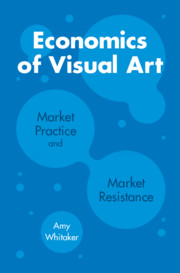7 - Labor
Published online by Cambridge University Press: 23 July 2021
Summary
In this chapter we explore labor as a special category of markets. The supply of labor is governed by two forces – the income effect and the substitution effect. Workers supply their labor in ways that are reflected in a backward-bending supply curve. Workers are willing to take more paid work up to a point at which the opportunity cost of leisure becomes so great that the worker will no longer trade leisure for income. In the arts, so many forms of labor are uncompensated or not sustainably paid. We consider the early history of the Hansa Gallery in the 1950s as a case in point. We look at unions and collective bargaining as strategies and we look at diversity, equity, L16and inclusion as a cost of labor policies. For artists, the organization W.A.G.E. tries to lobby collectively for artists to be paid exhibition fees.
- Type
- Chapter
- Information
- Economics of Visual ArtMarket Practice and Market Resistance, pp. 177 - 197Publisher: Cambridge University PressPrint publication year: 2021

